Assessing Influencer Marketing: A Retail Communication Strategy
VerifiedAdded on 2023/02/01
|16
|4558
|54
Report
AI Summary
This report assesses the advantages and disadvantages of incorporating celebrities and social influencers into a retailer's marketing communications strategy. It explores the increasing significance of social media and influencer marketing, highlighting how influencers leverage authenticity and credibility to attract consumers. The report outlines the benefits, such as increased brand awareness, viral influence, and impact on the Zero Moment of Truth (ZMOT). It also discusses the risks, including fraud, relationship breakdowns, lack of trust, and ethical issues. The report uses the 'Kendall Jenner with Pepsi' advertisement as a detailed example to illustrate the potential pitfalls of influencer marketing, particularly focusing on the negative impact and reputational damage that can arise from poorly executed campaigns. The report provides a comprehensive overview of the current landscape of influencer marketing and offers valuable insights into its strategic implementation.
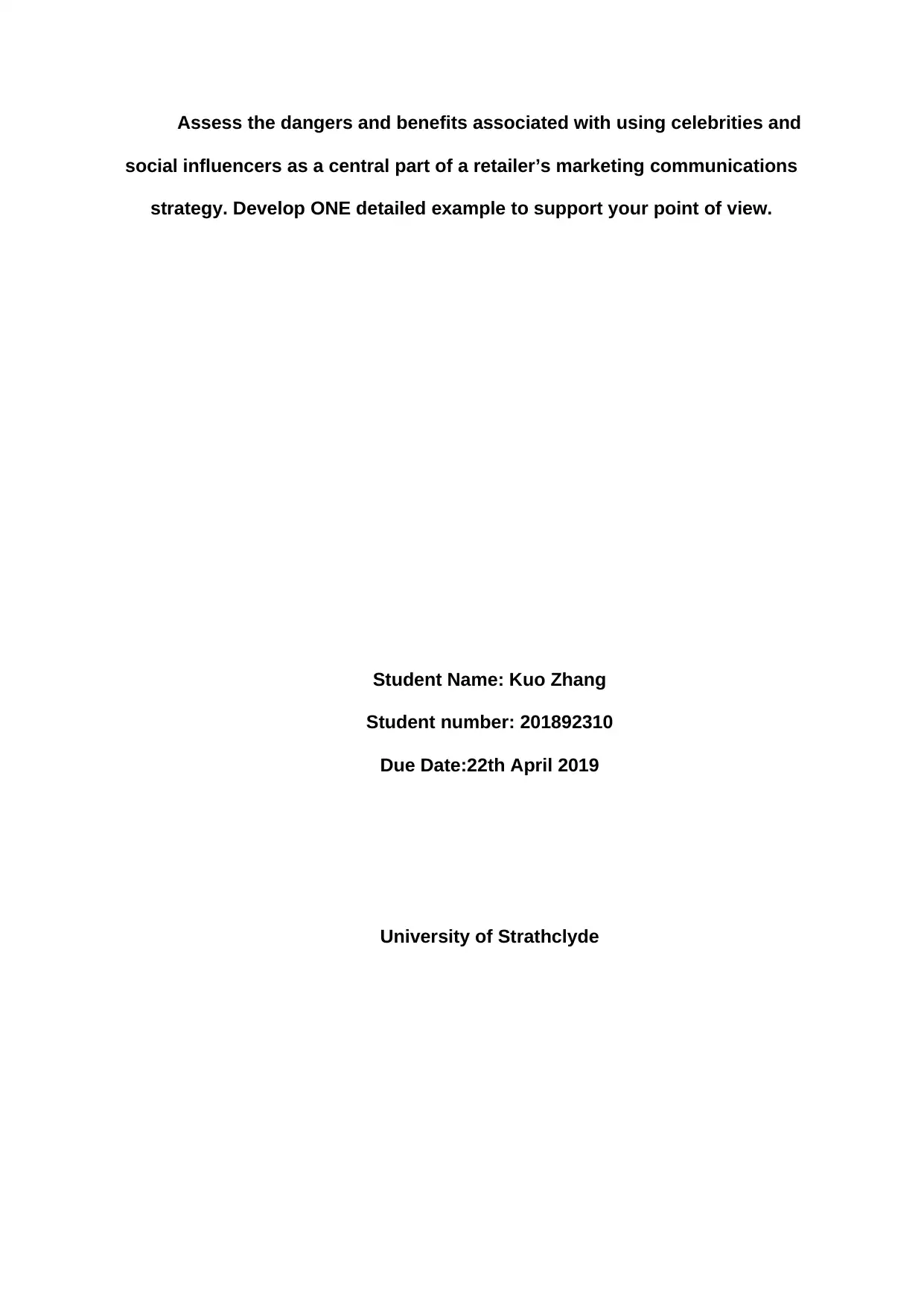
Assess the dangers and benefits associated with using celebrities and
social influencers as a central part of a retailer’s marketing communications
strategy. Develop ONE detailed example to support your point of view.
Student Name: Kuo Zhang
Student number: 201892310
Due Date:22th April 2019
University of Strathclyde
social influencers as a central part of a retailer’s marketing communications
strategy. Develop ONE detailed example to support your point of view.
Student Name: Kuo Zhang
Student number: 201892310
Due Date:22th April 2019
University of Strathclyde
Paraphrase This Document
Need a fresh take? Get an instant paraphrase of this document with our AI Paraphraser
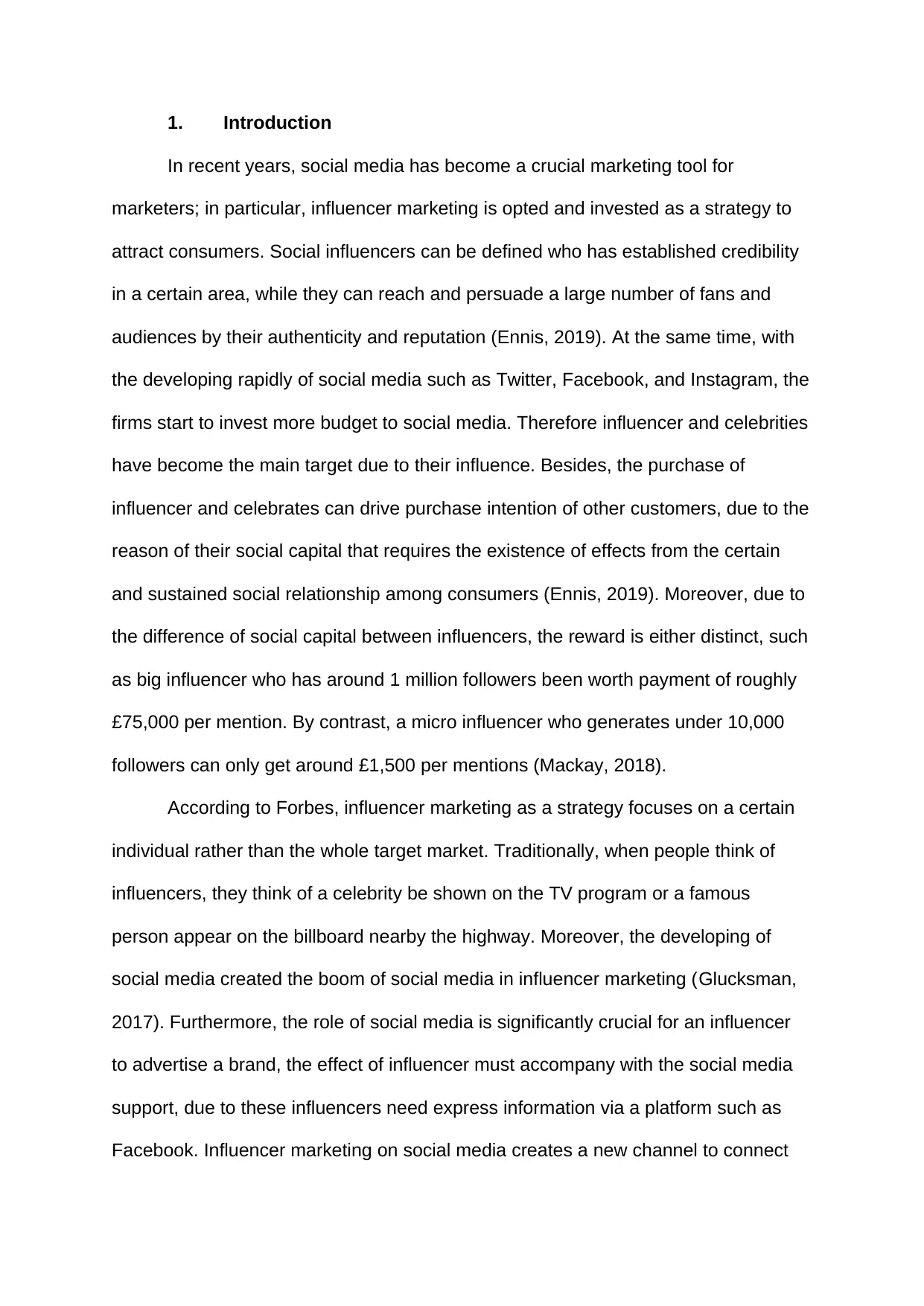
1. Introduction
In recent years, social media has become a crucial marketing tool for
marketers; in particular, influencer marketing is opted and invested as a strategy to
attract consumers. Social influencers can be defined who has established credibility
in a certain area, while they can reach and persuade a large number of fans and
audiences by their authenticity and reputation (Ennis, 2019). At the same time, with
the developing rapidly of social media such as Twitter, Facebook, and Instagram, the
firms start to invest more budget to social media. Therefore influencer and celebrities
have become the main target due to their influence. Besides, the purchase of
influencer and celebrates can drive purchase intention of other customers, due to the
reason of their social capital that requires the existence of effects from the certain
and sustained social relationship among consumers (Ennis, 2019). Moreover, due to
the difference of social capital between influencers, the reward is either distinct, such
as big influencer who has around 1 million followers been worth payment of roughly
£75,000 per mention. By contrast, a micro influencer who generates under 10,000
followers can only get around £1,500 per mentions (Mackay, 2018).
According to Forbes, influencer marketing as a strategy focuses on a certain
individual rather than the whole target market. Traditionally, when people think of
influencers, they think of a celebrity be shown on the TV program or a famous
person appear on the billboard nearby the highway. Moreover, the developing of
social media created the boom of social media in influencer marketing (Glucksman,
2017). Furthermore, the role of social media is significantly crucial for an influencer
to advertise a brand, the effect of influencer must accompany with the social media
support, due to these influencers need express information via a platform such as
Facebook. Influencer marketing on social media creates a new channel to connect
In recent years, social media has become a crucial marketing tool for
marketers; in particular, influencer marketing is opted and invested as a strategy to
attract consumers. Social influencers can be defined who has established credibility
in a certain area, while they can reach and persuade a large number of fans and
audiences by their authenticity and reputation (Ennis, 2019). At the same time, with
the developing rapidly of social media such as Twitter, Facebook, and Instagram, the
firms start to invest more budget to social media. Therefore influencer and celebrities
have become the main target due to their influence. Besides, the purchase of
influencer and celebrates can drive purchase intention of other customers, due to the
reason of their social capital that requires the existence of effects from the certain
and sustained social relationship among consumers (Ennis, 2019). Moreover, due to
the difference of social capital between influencers, the reward is either distinct, such
as big influencer who has around 1 million followers been worth payment of roughly
£75,000 per mention. By contrast, a micro influencer who generates under 10,000
followers can only get around £1,500 per mentions (Mackay, 2018).
According to Forbes, influencer marketing as a strategy focuses on a certain
individual rather than the whole target market. Traditionally, when people think of
influencers, they think of a celebrity be shown on the TV program or a famous
person appear on the billboard nearby the highway. Moreover, the developing of
social media created the boom of social media in influencer marketing (Glucksman,
2017). Furthermore, the role of social media is significantly crucial for an influencer
to advertise a brand, the effect of influencer must accompany with the social media
support, due to these influencers need express information via a platform such as
Facebook. Influencer marketing on social media creates a new channel to connect
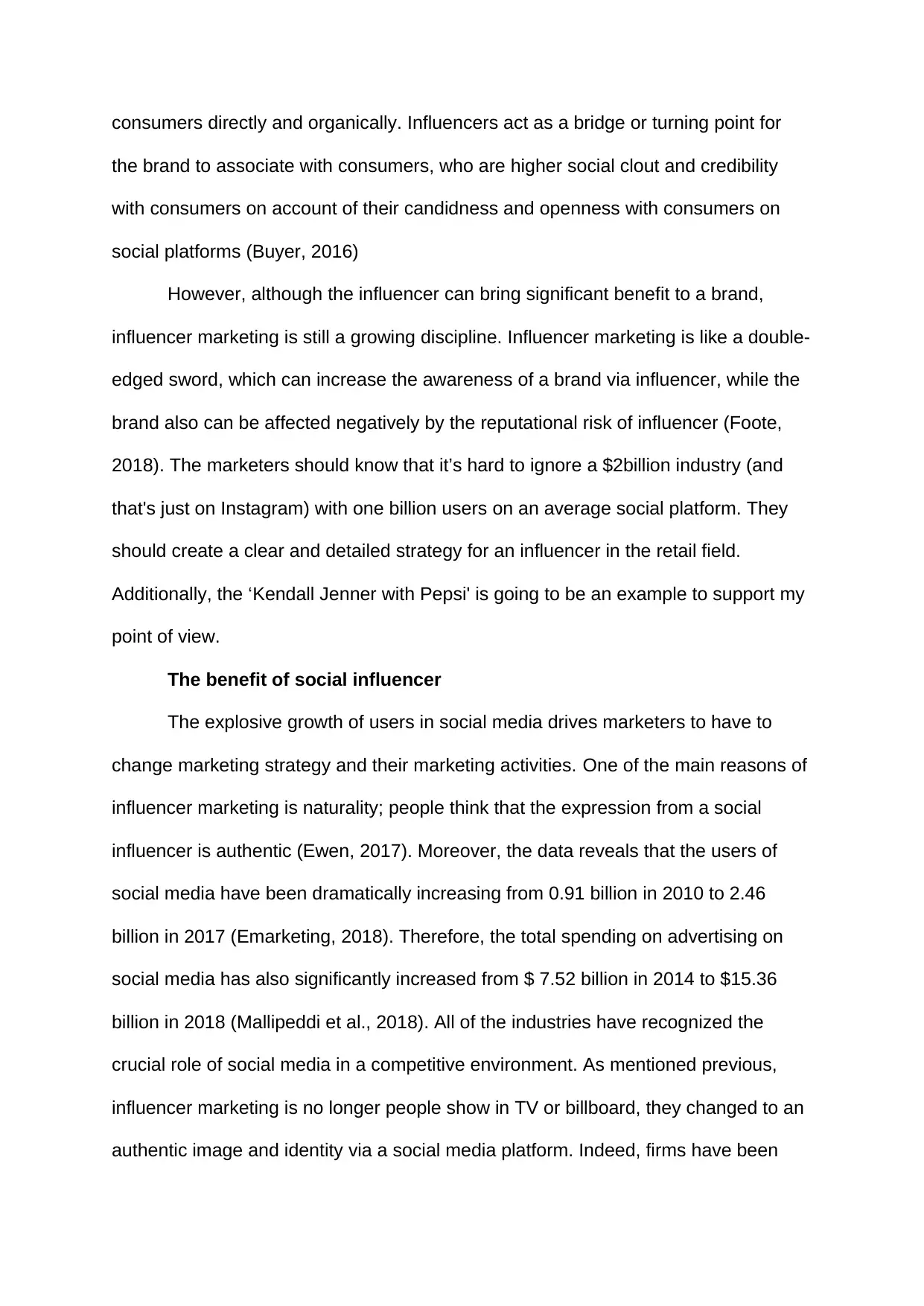
consumers directly and organically. Influencers act as a bridge or turning point for
the brand to associate with consumers, who are higher social clout and credibility
with consumers on account of their candidness and openness with consumers on
social platforms (Buyer, 2016)
However, although the influencer can bring significant benefit to a brand,
influencer marketing is still a growing discipline. Influencer marketing is like a double-
edged sword, which can increase the awareness of a brand via influencer, while the
brand also can be affected negatively by the reputational risk of influencer (Foote,
2018). The marketers should know that it’s hard to ignore a $2billion industry (and
that's just on Instagram) with one billion users on an average social platform. They
should create a clear and detailed strategy for an influencer in the retail field.
Additionally, the ‘Kendall Jenner with Pepsi' is going to be an example to support my
point of view.
The benefit of social influencer
The explosive growth of users in social media drives marketers to have to
change marketing strategy and their marketing activities. One of the main reasons of
influencer marketing is naturality; people think that the expression from a social
influencer is authentic (Ewen, 2017). Moreover, the data reveals that the users of
social media have been dramatically increasing from 0.91 billion in 2010 to 2.46
billion in 2017 (Emarketing, 2018). Therefore, the total spending on advertising on
social media has also significantly increased from $ 7.52 billion in 2014 to $15.36
billion in 2018 (Mallipeddi et al., 2018). All of the industries have recognized the
crucial role of social media in a competitive environment. As mentioned previous,
influencer marketing is no longer people show in TV or billboard, they changed to an
authentic image and identity via a social media platform. Indeed, firms have been
the brand to associate with consumers, who are higher social clout and credibility
with consumers on account of their candidness and openness with consumers on
social platforms (Buyer, 2016)
However, although the influencer can bring significant benefit to a brand,
influencer marketing is still a growing discipline. Influencer marketing is like a double-
edged sword, which can increase the awareness of a brand via influencer, while the
brand also can be affected negatively by the reputational risk of influencer (Foote,
2018). The marketers should know that it’s hard to ignore a $2billion industry (and
that's just on Instagram) with one billion users on an average social platform. They
should create a clear and detailed strategy for an influencer in the retail field.
Additionally, the ‘Kendall Jenner with Pepsi' is going to be an example to support my
point of view.
The benefit of social influencer
The explosive growth of users in social media drives marketers to have to
change marketing strategy and their marketing activities. One of the main reasons of
influencer marketing is naturality; people think that the expression from a social
influencer is authentic (Ewen, 2017). Moreover, the data reveals that the users of
social media have been dramatically increasing from 0.91 billion in 2010 to 2.46
billion in 2017 (Emarketing, 2018). Therefore, the total spending on advertising on
social media has also significantly increased from $ 7.52 billion in 2014 to $15.36
billion in 2018 (Mallipeddi et al., 2018). All of the industries have recognized the
crucial role of social media in a competitive environment. As mentioned previous,
influencer marketing is no longer people show in TV or billboard, they changed to an
authentic image and identity via a social media platform. Indeed, firms have been
⊘ This is a preview!⊘
Do you want full access?
Subscribe today to unlock all pages.

Trusted by 1+ million students worldwide
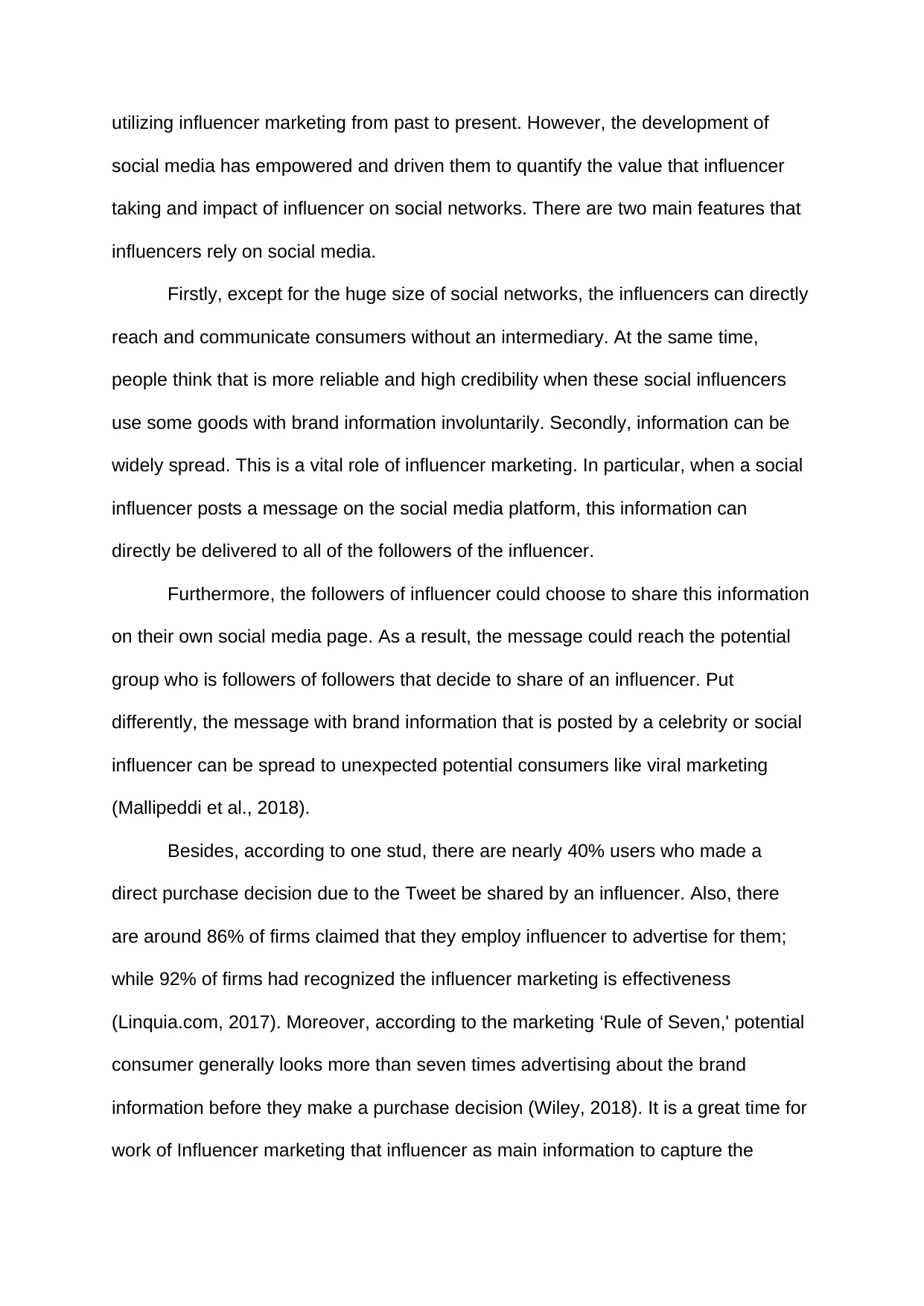
utilizing influencer marketing from past to present. However, the development of
social media has empowered and driven them to quantify the value that influencer
taking and impact of influencer on social networks. There are two main features that
influencers rely on social media.
Firstly, except for the huge size of social networks, the influencers can directly
reach and communicate consumers without an intermediary. At the same time,
people think that is more reliable and high credibility when these social influencers
use some goods with brand information involuntarily. Secondly, information can be
widely spread. This is a vital role of influencer marketing. In particular, when a social
influencer posts a message on the social media platform, this information can
directly be delivered to all of the followers of the influencer.
Furthermore, the followers of influencer could choose to share this information
on their own social media page. As a result, the message could reach the potential
group who is followers of followers that decide to share of an influencer. Put
differently, the message with brand information that is posted by a celebrity or social
influencer can be spread to unexpected potential consumers like viral marketing
(Mallipeddi et al., 2018).
Besides, according to one stud, there are nearly 40% users who made a
direct purchase decision due to the Tweet be shared by an influencer. Also, there
are around 86% of firms claimed that they employ influencer to advertise for them;
while 92% of firms had recognized the influencer marketing is effectiveness
(Linquia.com, 2017). Moreover, according to the marketing ‘Rule of Seven,' potential
consumer generally looks more than seven times advertising about the brand
information before they make a purchase decision (Wiley, 2018). It is a great time for
work of Influencer marketing that influencer as main information to capture the
social media has empowered and driven them to quantify the value that influencer
taking and impact of influencer on social networks. There are two main features that
influencers rely on social media.
Firstly, except for the huge size of social networks, the influencers can directly
reach and communicate consumers without an intermediary. At the same time,
people think that is more reliable and high credibility when these social influencers
use some goods with brand information involuntarily. Secondly, information can be
widely spread. This is a vital role of influencer marketing. In particular, when a social
influencer posts a message on the social media platform, this information can
directly be delivered to all of the followers of the influencer.
Furthermore, the followers of influencer could choose to share this information
on their own social media page. As a result, the message could reach the potential
group who is followers of followers that decide to share of an influencer. Put
differently, the message with brand information that is posted by a celebrity or social
influencer can be spread to unexpected potential consumers like viral marketing
(Mallipeddi et al., 2018).
Besides, according to one stud, there are nearly 40% users who made a
direct purchase decision due to the Tweet be shared by an influencer. Also, there
are around 86% of firms claimed that they employ influencer to advertise for them;
while 92% of firms had recognized the influencer marketing is effectiveness
(Linquia.com, 2017). Moreover, according to the marketing ‘Rule of Seven,' potential
consumer generally looks more than seven times advertising about the brand
information before they make a purchase decision (Wiley, 2018). It is a great time for
work of Influencer marketing that influencer as main information to capture the
Paraphrase This Document
Need a fresh take? Get an instant paraphrase of this document with our AI Paraphraser
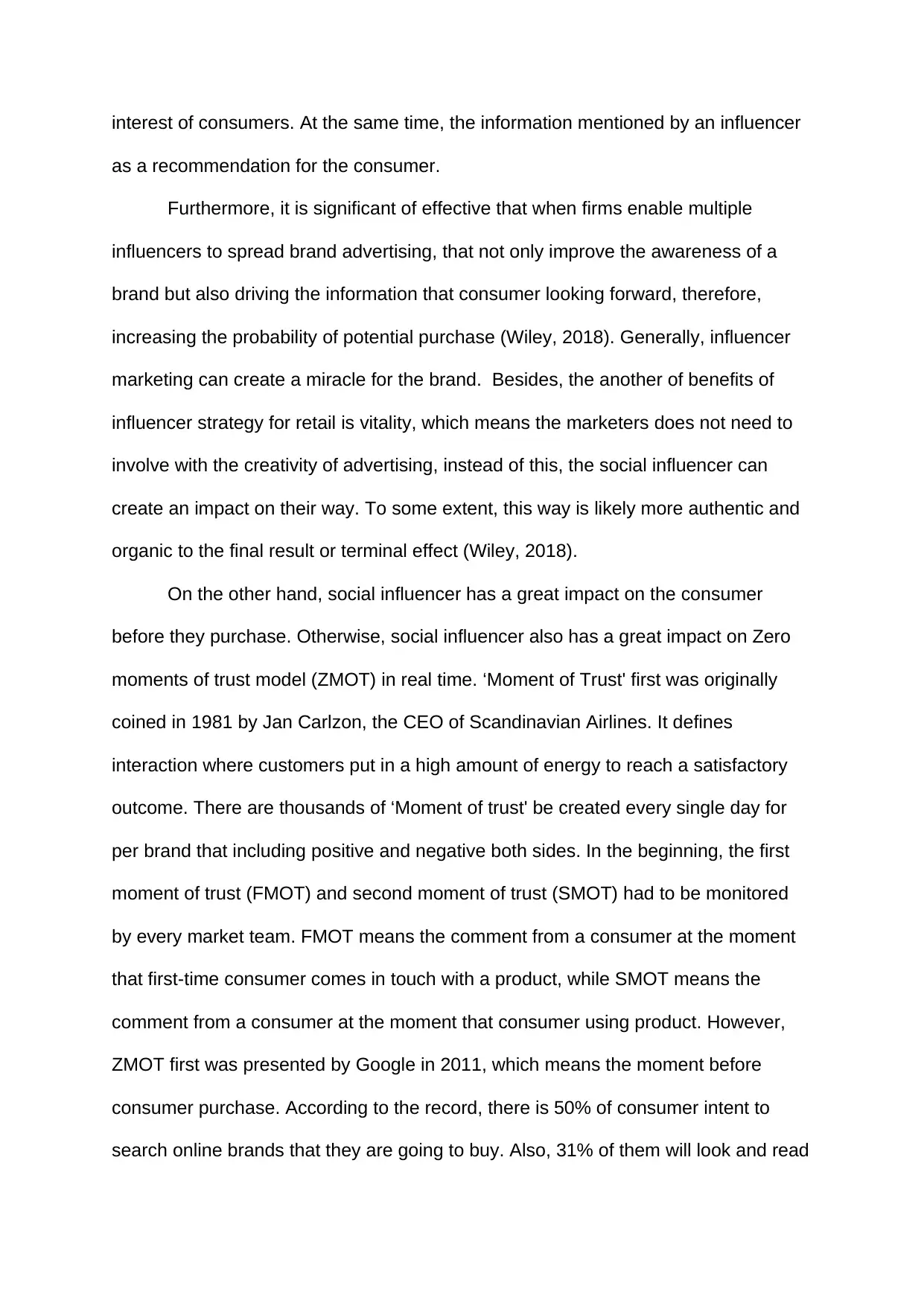
interest of consumers. At the same time, the information mentioned by an influencer
as a recommendation for the consumer.
Furthermore, it is significant of effective that when firms enable multiple
influencers to spread brand advertising, that not only improve the awareness of a
brand but also driving the information that consumer looking forward, therefore,
increasing the probability of potential purchase (Wiley, 2018). Generally, influencer
marketing can create a miracle for the brand. Besides, the another of benefits of
influencer strategy for retail is vitality, which means the marketers does not need to
involve with the creativity of advertising, instead of this, the social influencer can
create an impact on their way. To some extent, this way is likely more authentic and
organic to the final result or terminal effect (Wiley, 2018).
On the other hand, social influencer has a great impact on the consumer
before they purchase. Otherwise, social influencer also has a great impact on Zero
moments of trust model (ZMOT) in real time. ‘Moment of Trust' first was originally
coined in 1981 by Jan Carlzon, the CEO of Scandinavian Airlines. It defines
interaction where customers put in a high amount of energy to reach a satisfactory
outcome. There are thousands of ‘Moment of trust' be created every single day for
per brand that including positive and negative both sides. In the beginning, the first
moment of trust (FMOT) and second moment of trust (SMOT) had to be monitored
by every market team. FMOT means the comment from a consumer at the moment
that first-time consumer comes in touch with a product, while SMOT means the
comment from a consumer at the moment that consumer using product. However,
ZMOT first was presented by Google in 2011, which means the moment before
consumer purchase. According to the record, there is 50% of consumer intent to
search online brands that they are going to buy. Also, 31% of them will look and read
as a recommendation for the consumer.
Furthermore, it is significant of effective that when firms enable multiple
influencers to spread brand advertising, that not only improve the awareness of a
brand but also driving the information that consumer looking forward, therefore,
increasing the probability of potential purchase (Wiley, 2018). Generally, influencer
marketing can create a miracle for the brand. Besides, the another of benefits of
influencer strategy for retail is vitality, which means the marketers does not need to
involve with the creativity of advertising, instead of this, the social influencer can
create an impact on their way. To some extent, this way is likely more authentic and
organic to the final result or terminal effect (Wiley, 2018).
On the other hand, social influencer has a great impact on the consumer
before they purchase. Otherwise, social influencer also has a great impact on Zero
moments of trust model (ZMOT) in real time. ‘Moment of Trust' first was originally
coined in 1981 by Jan Carlzon, the CEO of Scandinavian Airlines. It defines
interaction where customers put in a high amount of energy to reach a satisfactory
outcome. There are thousands of ‘Moment of trust' be created every single day for
per brand that including positive and negative both sides. In the beginning, the first
moment of trust (FMOT) and second moment of trust (SMOT) had to be monitored
by every market team. FMOT means the comment from a consumer at the moment
that first-time consumer comes in touch with a product, while SMOT means the
comment from a consumer at the moment that consumer using product. However,
ZMOT first was presented by Google in 2011, which means the moment before
consumer purchase. According to the record, there is 50% of consumer intent to
search online brands that they are going to buy. Also, 31% of them will look and read
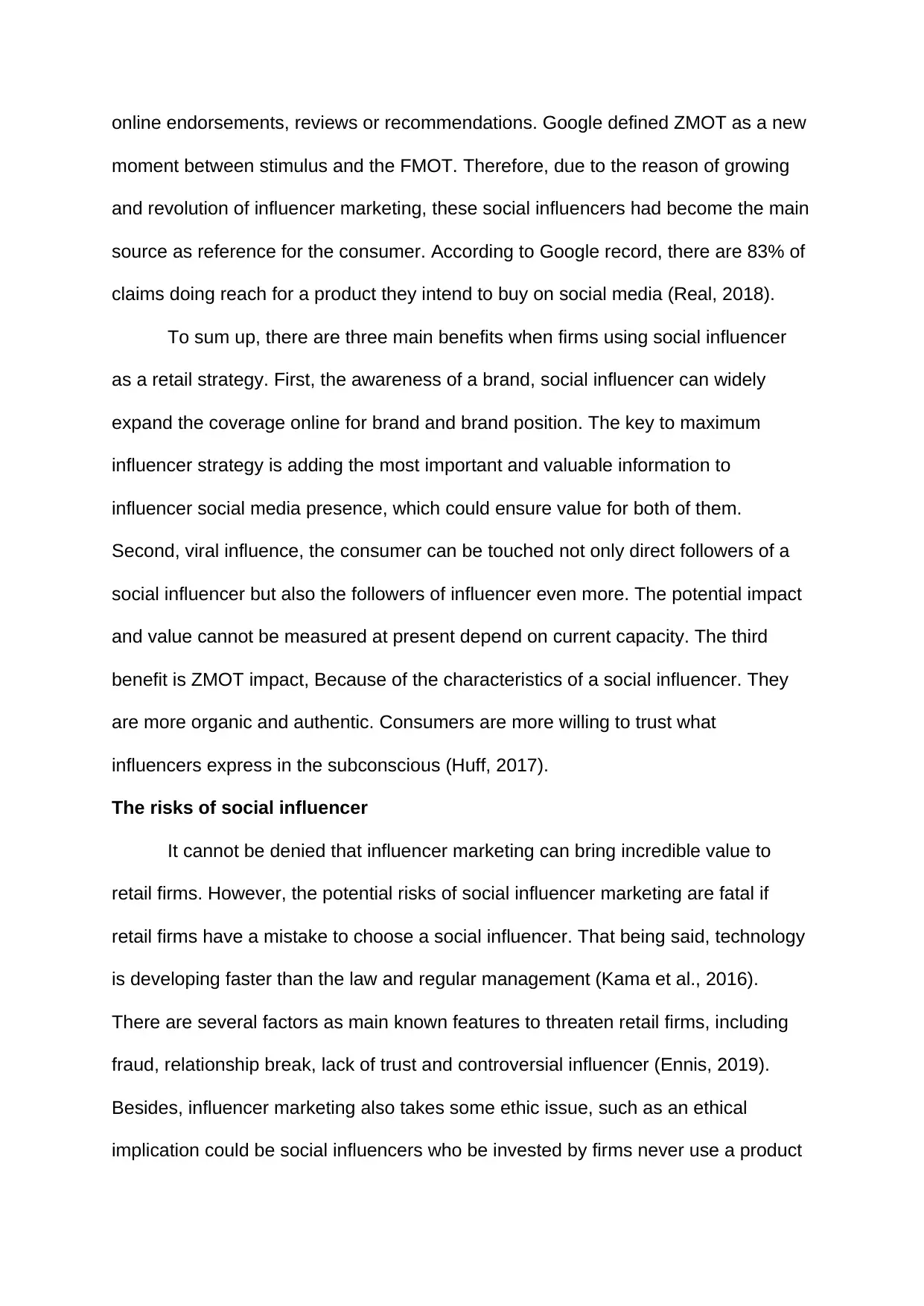
online endorsements, reviews or recommendations. Google defined ZMOT as a new
moment between stimulus and the FMOT. Therefore, due to the reason of growing
and revolution of influencer marketing, these social influencers had become the main
source as reference for the consumer. According to Google record, there are 83% of
claims doing reach for a product they intend to buy on social media (Real, 2018).
To sum up, there are three main benefits when firms using social influencer
as a retail strategy. First, the awareness of a brand, social influencer can widely
expand the coverage online for brand and brand position. The key to maximum
influencer strategy is adding the most important and valuable information to
influencer social media presence, which could ensure value for both of them.
Second, viral influence, the consumer can be touched not only direct followers of a
social influencer but also the followers of influencer even more. The potential impact
and value cannot be measured at present depend on current capacity. The third
benefit is ZMOT impact, Because of the characteristics of a social influencer. They
are more organic and authentic. Consumers are more willing to trust what
influencers express in the subconscious (Huff, 2017).
The risks of social influencer
It cannot be denied that influencer marketing can bring incredible value to
retail firms. However, the potential risks of social influencer marketing are fatal if
retail firms have a mistake to choose a social influencer. That being said, technology
is developing faster than the law and regular management (Kama et al., 2016).
There are several factors as main known features to threaten retail firms, including
fraud, relationship break, lack of trust and controversial influencer (Ennis, 2019).
Besides, influencer marketing also takes some ethic issue, such as an ethical
implication could be social influencers who be invested by firms never use a product
moment between stimulus and the FMOT. Therefore, due to the reason of growing
and revolution of influencer marketing, these social influencers had become the main
source as reference for the consumer. According to Google record, there are 83% of
claims doing reach for a product they intend to buy on social media (Real, 2018).
To sum up, there are three main benefits when firms using social influencer
as a retail strategy. First, the awareness of a brand, social influencer can widely
expand the coverage online for brand and brand position. The key to maximum
influencer strategy is adding the most important and valuable information to
influencer social media presence, which could ensure value for both of them.
Second, viral influence, the consumer can be touched not only direct followers of a
social influencer but also the followers of influencer even more. The potential impact
and value cannot be measured at present depend on current capacity. The third
benefit is ZMOT impact, Because of the characteristics of a social influencer. They
are more organic and authentic. Consumers are more willing to trust what
influencers express in the subconscious (Huff, 2017).
The risks of social influencer
It cannot be denied that influencer marketing can bring incredible value to
retail firms. However, the potential risks of social influencer marketing are fatal if
retail firms have a mistake to choose a social influencer. That being said, technology
is developing faster than the law and regular management (Kama et al., 2016).
There are several factors as main known features to threaten retail firms, including
fraud, relationship break, lack of trust and controversial influencer (Ennis, 2019).
Besides, influencer marketing also takes some ethic issue, such as an ethical
implication could be social influencers who be invested by firms never use a product
⊘ This is a preview!⊘
Do you want full access?
Subscribe today to unlock all pages.

Trusted by 1+ million students worldwide
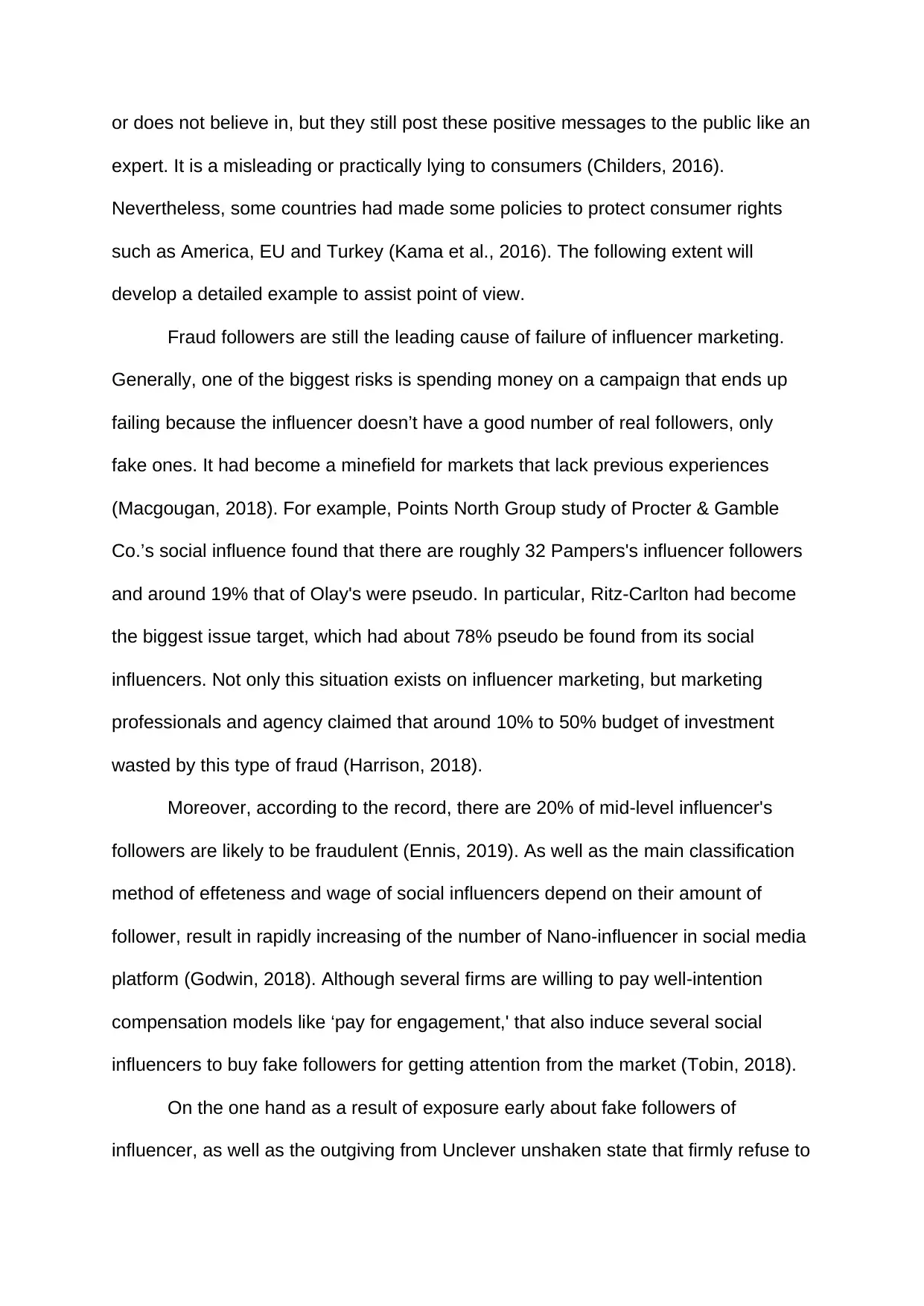
or does not believe in, but they still post these positive messages to the public like an
expert. It is a misleading or practically lying to consumers (Childers, 2016).
Nevertheless, some countries had made some policies to protect consumer rights
such as America, EU and Turkey (Kama et al., 2016). The following extent will
develop a detailed example to assist point of view.
Fraud followers are still the leading cause of failure of influencer marketing.
Generally, one of the biggest risks is spending money on a campaign that ends up
failing because the influencer doesn’t have a good number of real followers, only
fake ones. It had become a minefield for markets that lack previous experiences
(Macgougan, 2018). For example, Points North Group study of Procter & Gamble
Co.’s social influence found that there are roughly 32 Pampers's influencer followers
and around 19% that of Olay's were pseudo. In particular, Ritz-Carlton had become
the biggest issue target, which had about 78% pseudo be found from its social
influencers. Not only this situation exists on influencer marketing, but marketing
professionals and agency claimed that around 10% to 50% budget of investment
wasted by this type of fraud (Harrison, 2018).
Moreover, according to the record, there are 20% of mid-level influencer's
followers are likely to be fraudulent (Ennis, 2019). As well as the main classification
method of effeteness and wage of social influencers depend on their amount of
follower, result in rapidly increasing of the number of Nano-influencer in social media
platform (Godwin, 2018). Although several firms are willing to pay well-intention
compensation models like ‘pay for engagement,' that also induce several social
influencers to buy fake followers for getting attention from the market (Tobin, 2018).
On the one hand as a result of exposure early about fake followers of
influencer, as well as the outgiving from Unclever unshaken state that firmly refuse to
expert. It is a misleading or practically lying to consumers (Childers, 2016).
Nevertheless, some countries had made some policies to protect consumer rights
such as America, EU and Turkey (Kama et al., 2016). The following extent will
develop a detailed example to assist point of view.
Fraud followers are still the leading cause of failure of influencer marketing.
Generally, one of the biggest risks is spending money on a campaign that ends up
failing because the influencer doesn’t have a good number of real followers, only
fake ones. It had become a minefield for markets that lack previous experiences
(Macgougan, 2018). For example, Points North Group study of Procter & Gamble
Co.’s social influence found that there are roughly 32 Pampers's influencer followers
and around 19% that of Olay's were pseudo. In particular, Ritz-Carlton had become
the biggest issue target, which had about 78% pseudo be found from its social
influencers. Not only this situation exists on influencer marketing, but marketing
professionals and agency claimed that around 10% to 50% budget of investment
wasted by this type of fraud (Harrison, 2018).
Moreover, according to the record, there are 20% of mid-level influencer's
followers are likely to be fraudulent (Ennis, 2019). As well as the main classification
method of effeteness and wage of social influencers depend on their amount of
follower, result in rapidly increasing of the number of Nano-influencer in social media
platform (Godwin, 2018). Although several firms are willing to pay well-intention
compensation models like ‘pay for engagement,' that also induce several social
influencers to buy fake followers for getting attention from the market (Tobin, 2018).
On the one hand as a result of exposure early about fake followers of
influencer, as well as the outgiving from Unclever unshaken state that firmly refuse to
Paraphrase This Document
Need a fresh take? Get an instant paraphrase of this document with our AI Paraphraser
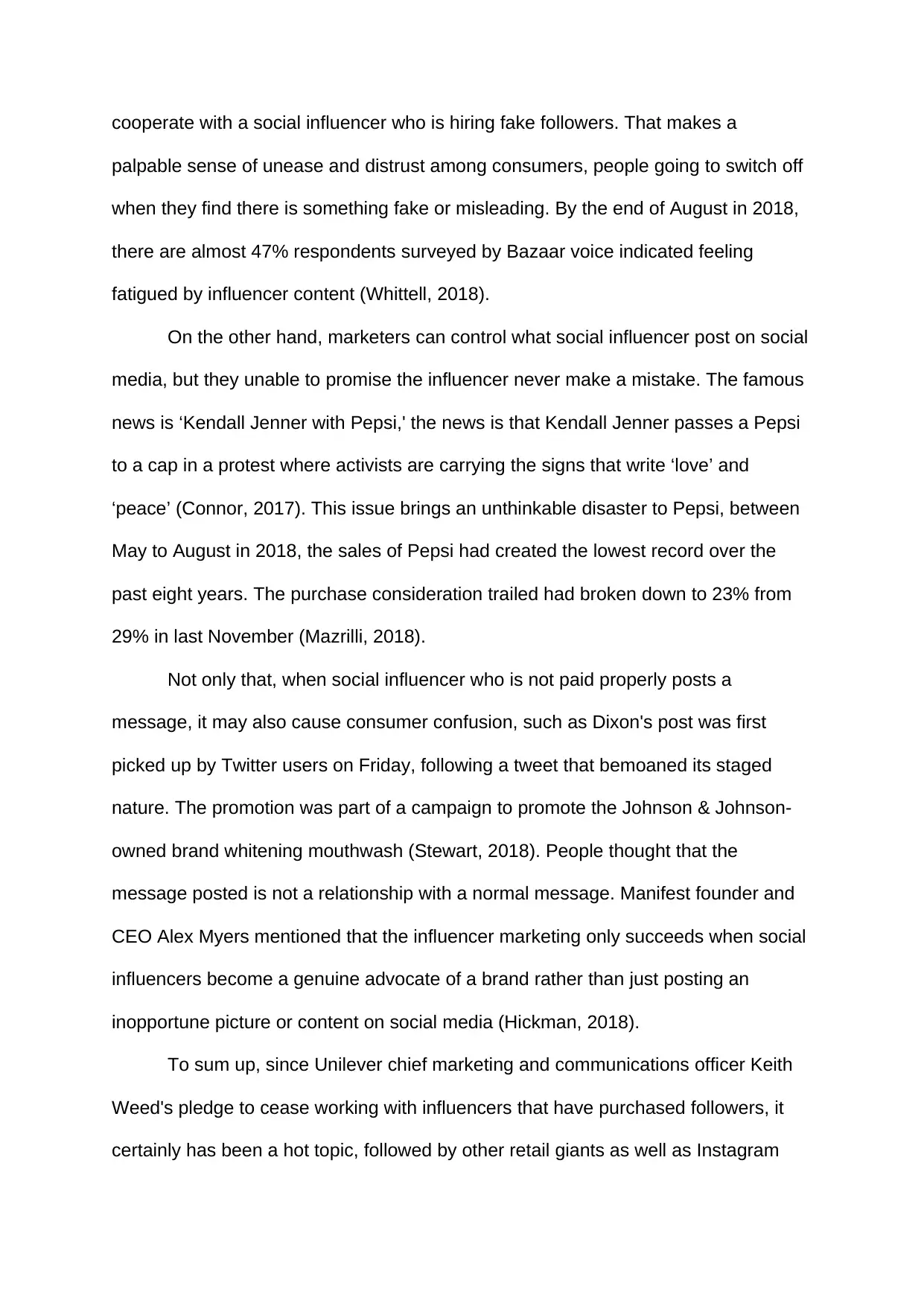
cooperate with a social influencer who is hiring fake followers. That makes a
palpable sense of unease and distrust among consumers, people going to switch off
when they find there is something fake or misleading. By the end of August in 2018,
there are almost 47% respondents surveyed by Bazaar voice indicated feeling
fatigued by influencer content (Whittell, 2018).
On the other hand, marketers can control what social influencer post on social
media, but they unable to promise the influencer never make a mistake. The famous
news is ‘Kendall Jenner with Pepsi,' the news is that Kendall Jenner passes a Pepsi
to a cap in a protest where activists are carrying the signs that write ‘love’ and
‘peace’ (Connor, 2017). This issue brings an unthinkable disaster to Pepsi, between
May to August in 2018, the sales of Pepsi had created the lowest record over the
past eight years. The purchase consideration trailed had broken down to 23% from
29% in last November (Mazrilli, 2018).
Not only that, when social influencer who is not paid properly posts a
message, it may also cause consumer confusion, such as Dixon's post was first
picked up by Twitter users on Friday, following a tweet that bemoaned its staged
nature. The promotion was part of a campaign to promote the Johnson & Johnson-
owned brand whitening mouthwash (Stewart, 2018). People thought that the
message posted is not a relationship with a normal message. Manifest founder and
CEO Alex Myers mentioned that the influencer marketing only succeeds when social
influencers become a genuine advocate of a brand rather than just posting an
inopportune picture or content on social media (Hickman, 2018).
To sum up, since Unilever chief marketing and communications officer Keith
Weed's pledge to cease working with influencers that have purchased followers, it
certainly has been a hot topic, followed by other retail giants as well as Instagram
palpable sense of unease and distrust among consumers, people going to switch off
when they find there is something fake or misleading. By the end of August in 2018,
there are almost 47% respondents surveyed by Bazaar voice indicated feeling
fatigued by influencer content (Whittell, 2018).
On the other hand, marketers can control what social influencer post on social
media, but they unable to promise the influencer never make a mistake. The famous
news is ‘Kendall Jenner with Pepsi,' the news is that Kendall Jenner passes a Pepsi
to a cap in a protest where activists are carrying the signs that write ‘love’ and
‘peace’ (Connor, 2017). This issue brings an unthinkable disaster to Pepsi, between
May to August in 2018, the sales of Pepsi had created the lowest record over the
past eight years. The purchase consideration trailed had broken down to 23% from
29% in last November (Mazrilli, 2018).
Not only that, when social influencer who is not paid properly posts a
message, it may also cause consumer confusion, such as Dixon's post was first
picked up by Twitter users on Friday, following a tweet that bemoaned its staged
nature. The promotion was part of a campaign to promote the Johnson & Johnson-
owned brand whitening mouthwash (Stewart, 2018). People thought that the
message posted is not a relationship with a normal message. Manifest founder and
CEO Alex Myers mentioned that the influencer marketing only succeeds when social
influencers become a genuine advocate of a brand rather than just posting an
inopportune picture or content on social media (Hickman, 2018).
To sum up, since Unilever chief marketing and communications officer Keith
Weed's pledge to cease working with influencers that have purchased followers, it
certainly has been a hot topic, followed by other retail giants as well as Instagram
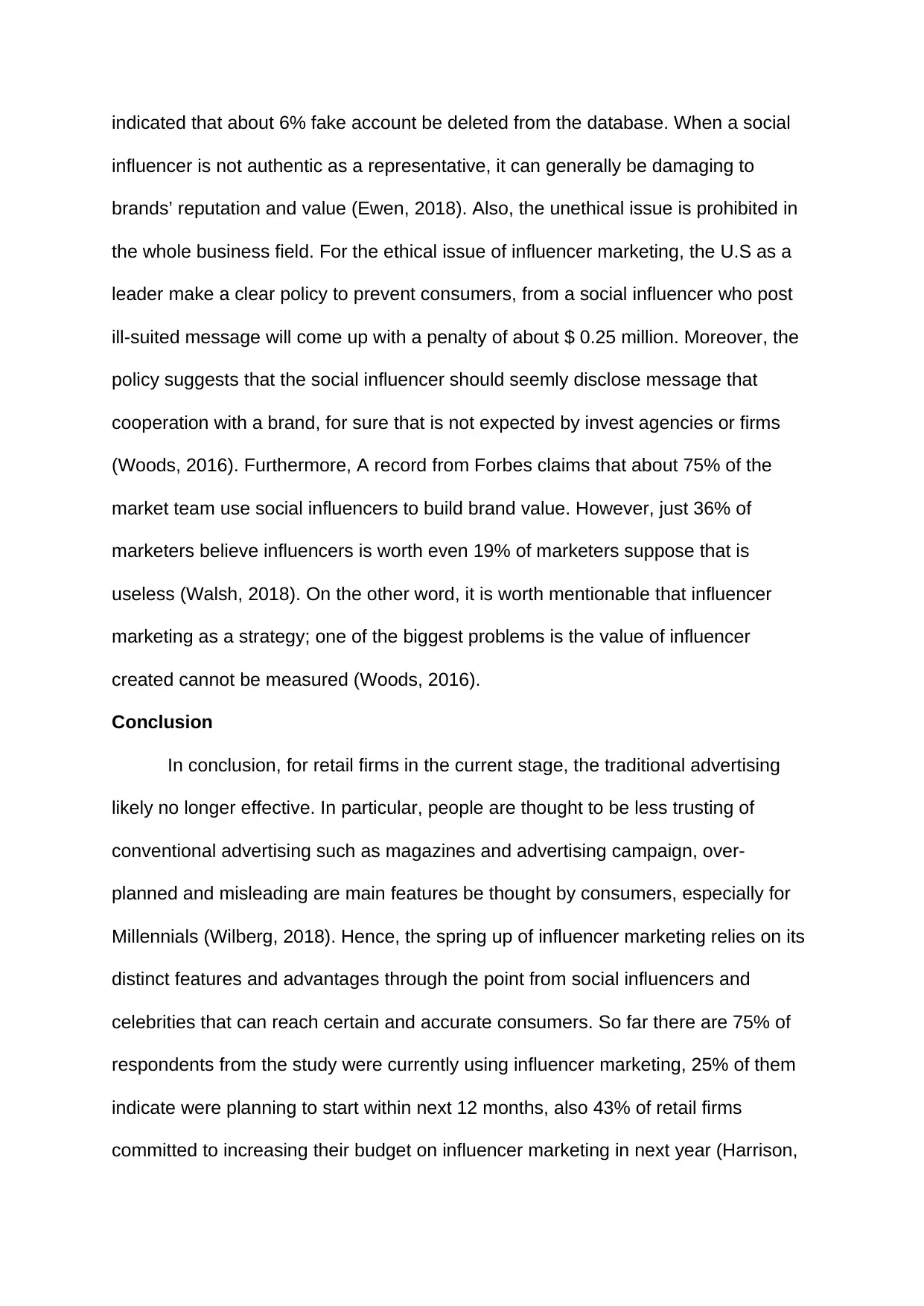
indicated that about 6% fake account be deleted from the database. When a social
influencer is not authentic as a representative, it can generally be damaging to
brands’ reputation and value (Ewen, 2018). Also, the unethical issue is prohibited in
the whole business field. For the ethical issue of influencer marketing, the U.S as a
leader make a clear policy to prevent consumers, from a social influencer who post
ill-suited message will come up with a penalty of about $ 0.25 million. Moreover, the
policy suggests that the social influencer should seemly disclose message that
cooperation with a brand, for sure that is not expected by invest agencies or firms
(Woods, 2016). Furthermore, A record from Forbes claims that about 75% of the
market team use social influencers to build brand value. However, just 36% of
marketers believe influencers is worth even 19% of marketers suppose that is
useless (Walsh, 2018). On the other word, it is worth mentionable that influencer
marketing as a strategy; one of the biggest problems is the value of influencer
created cannot be measured (Woods, 2016).
Conclusion
In conclusion, for retail firms in the current stage, the traditional advertising
likely no longer effective. In particular, people are thought to be less trusting of
conventional advertising such as magazines and advertising campaign, over-
planned and misleading are main features be thought by consumers, especially for
Millennials (Wilberg, 2018). Hence, the spring up of influencer marketing relies on its
distinct features and advantages through the point from social influencers and
celebrities that can reach certain and accurate consumers. So far there are 75% of
respondents from the study were currently using influencer marketing, 25% of them
indicate were planning to start within next 12 months, also 43% of retail firms
committed to increasing their budget on influencer marketing in next year (Harrison,
influencer is not authentic as a representative, it can generally be damaging to
brands’ reputation and value (Ewen, 2018). Also, the unethical issue is prohibited in
the whole business field. For the ethical issue of influencer marketing, the U.S as a
leader make a clear policy to prevent consumers, from a social influencer who post
ill-suited message will come up with a penalty of about $ 0.25 million. Moreover, the
policy suggests that the social influencer should seemly disclose message that
cooperation with a brand, for sure that is not expected by invest agencies or firms
(Woods, 2016). Furthermore, A record from Forbes claims that about 75% of the
market team use social influencers to build brand value. However, just 36% of
marketers believe influencers is worth even 19% of marketers suppose that is
useless (Walsh, 2018). On the other word, it is worth mentionable that influencer
marketing as a strategy; one of the biggest problems is the value of influencer
created cannot be measured (Woods, 2016).
Conclusion
In conclusion, for retail firms in the current stage, the traditional advertising
likely no longer effective. In particular, people are thought to be less trusting of
conventional advertising such as magazines and advertising campaign, over-
planned and misleading are main features be thought by consumers, especially for
Millennials (Wilberg, 2018). Hence, the spring up of influencer marketing relies on its
distinct features and advantages through the point from social influencers and
celebrities that can reach certain and accurate consumers. So far there are 75% of
respondents from the study were currently using influencer marketing, 25% of them
indicate were planning to start within next 12 months, also 43% of retail firms
committed to increasing their budget on influencer marketing in next year (Harrison,
⊘ This is a preview!⊘
Do you want full access?
Subscribe today to unlock all pages.

Trusted by 1+ million students worldwide
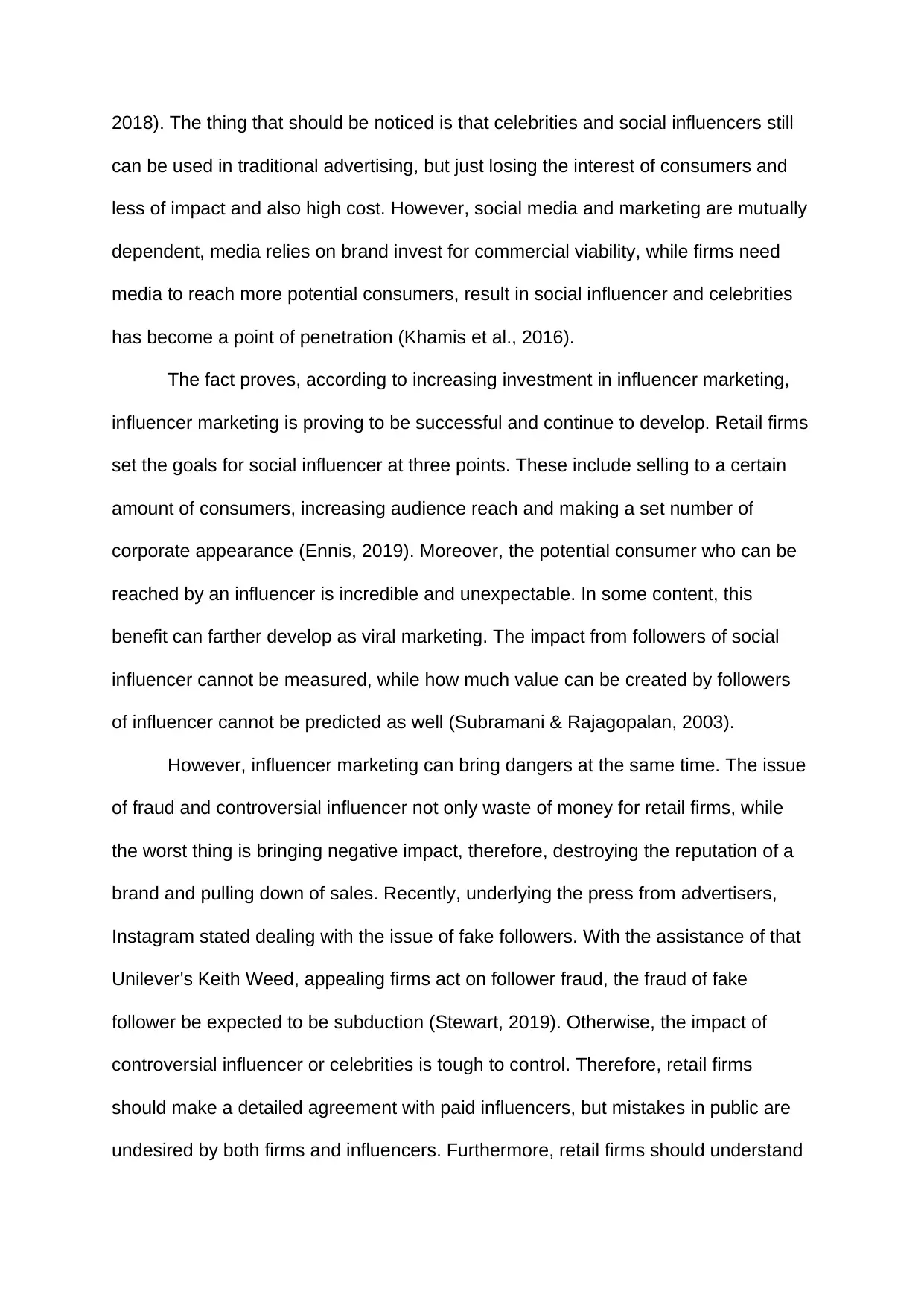
2018). The thing that should be noticed is that celebrities and social influencers still
can be used in traditional advertising, but just losing the interest of consumers and
less of impact and also high cost. However, social media and marketing are mutually
dependent, media relies on brand invest for commercial viability, while firms need
media to reach more potential consumers, result in social influencer and celebrities
has become a point of penetration (Khamis et al., 2016).
The fact proves, according to increasing investment in influencer marketing,
influencer marketing is proving to be successful and continue to develop. Retail firms
set the goals for social influencer at three points. These include selling to a certain
amount of consumers, increasing audience reach and making a set number of
corporate appearance (Ennis, 2019). Moreover, the potential consumer who can be
reached by an influencer is incredible and unexpectable. In some content, this
benefit can farther develop as viral marketing. The impact from followers of social
influencer cannot be measured, while how much value can be created by followers
of influencer cannot be predicted as well (Subramani & Rajagopalan, 2003).
However, influencer marketing can bring dangers at the same time. The issue
of fraud and controversial influencer not only waste of money for retail firms, while
the worst thing is bringing negative impact, therefore, destroying the reputation of a
brand and pulling down of sales. Recently, underlying the press from advertisers,
Instagram stated dealing with the issue of fake followers. With the assistance of that
Unilever's Keith Weed, appealing firms act on follower fraud, the fraud of fake
follower be expected to be subduction (Stewart, 2019). Otherwise, the impact of
controversial influencer or celebrities is tough to control. Therefore, retail firms
should make a detailed agreement with paid influencers, but mistakes in public are
undesired by both firms and influencers. Furthermore, retail firms should understand
can be used in traditional advertising, but just losing the interest of consumers and
less of impact and also high cost. However, social media and marketing are mutually
dependent, media relies on brand invest for commercial viability, while firms need
media to reach more potential consumers, result in social influencer and celebrities
has become a point of penetration (Khamis et al., 2016).
The fact proves, according to increasing investment in influencer marketing,
influencer marketing is proving to be successful and continue to develop. Retail firms
set the goals for social influencer at three points. These include selling to a certain
amount of consumers, increasing audience reach and making a set number of
corporate appearance (Ennis, 2019). Moreover, the potential consumer who can be
reached by an influencer is incredible and unexpectable. In some content, this
benefit can farther develop as viral marketing. The impact from followers of social
influencer cannot be measured, while how much value can be created by followers
of influencer cannot be predicted as well (Subramani & Rajagopalan, 2003).
However, influencer marketing can bring dangers at the same time. The issue
of fraud and controversial influencer not only waste of money for retail firms, while
the worst thing is bringing negative impact, therefore, destroying the reputation of a
brand and pulling down of sales. Recently, underlying the press from advertisers,
Instagram stated dealing with the issue of fake followers. With the assistance of that
Unilever's Keith Weed, appealing firms act on follower fraud, the fraud of fake
follower be expected to be subduction (Stewart, 2019). Otherwise, the impact of
controversial influencer or celebrities is tough to control. Therefore, retail firms
should make a detailed agreement with paid influencers, but mistakes in public are
undesired by both firms and influencers. Furthermore, retail firms should understand
Paraphrase This Document
Need a fresh take? Get an instant paraphrase of this document with our AI Paraphraser
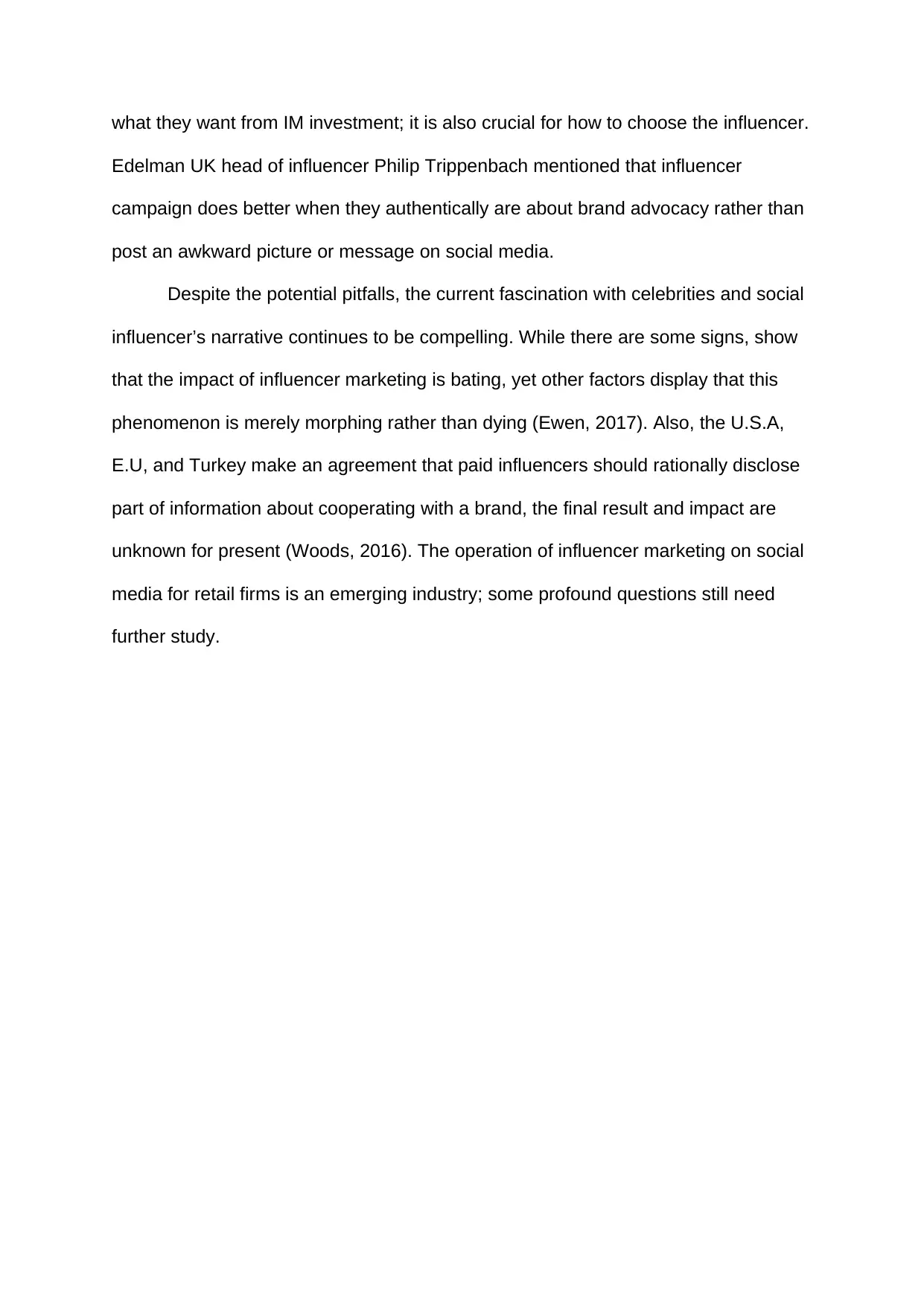
what they want from IM investment; it is also crucial for how to choose the influencer.
Edelman UK head of influencer Philip Trippenbach mentioned that influencer
campaign does better when they authentically are about brand advocacy rather than
post an awkward picture or message on social media.
Despite the potential pitfalls, the current fascination with celebrities and social
influencer’s narrative continues to be compelling. While there are some signs, show
that the impact of influencer marketing is bating, yet other factors display that this
phenomenon is merely morphing rather than dying (Ewen, 2017). Also, the U.S.A,
E.U, and Turkey make an agreement that paid influencers should rationally disclose
part of information about cooperating with a brand, the final result and impact are
unknown for present (Woods, 2016). The operation of influencer marketing on social
media for retail firms is an emerging industry; some profound questions still need
further study.
Edelman UK head of influencer Philip Trippenbach mentioned that influencer
campaign does better when they authentically are about brand advocacy rather than
post an awkward picture or message on social media.
Despite the potential pitfalls, the current fascination with celebrities and social
influencer’s narrative continues to be compelling. While there are some signs, show
that the impact of influencer marketing is bating, yet other factors display that this
phenomenon is merely morphing rather than dying (Ewen, 2017). Also, the U.S.A,
E.U, and Turkey make an agreement that paid influencers should rationally disclose
part of information about cooperating with a brand, the final result and impact are
unknown for present (Woods, 2016). The operation of influencer marketing on social
media for retail firms is an emerging industry; some profound questions still need
further study.
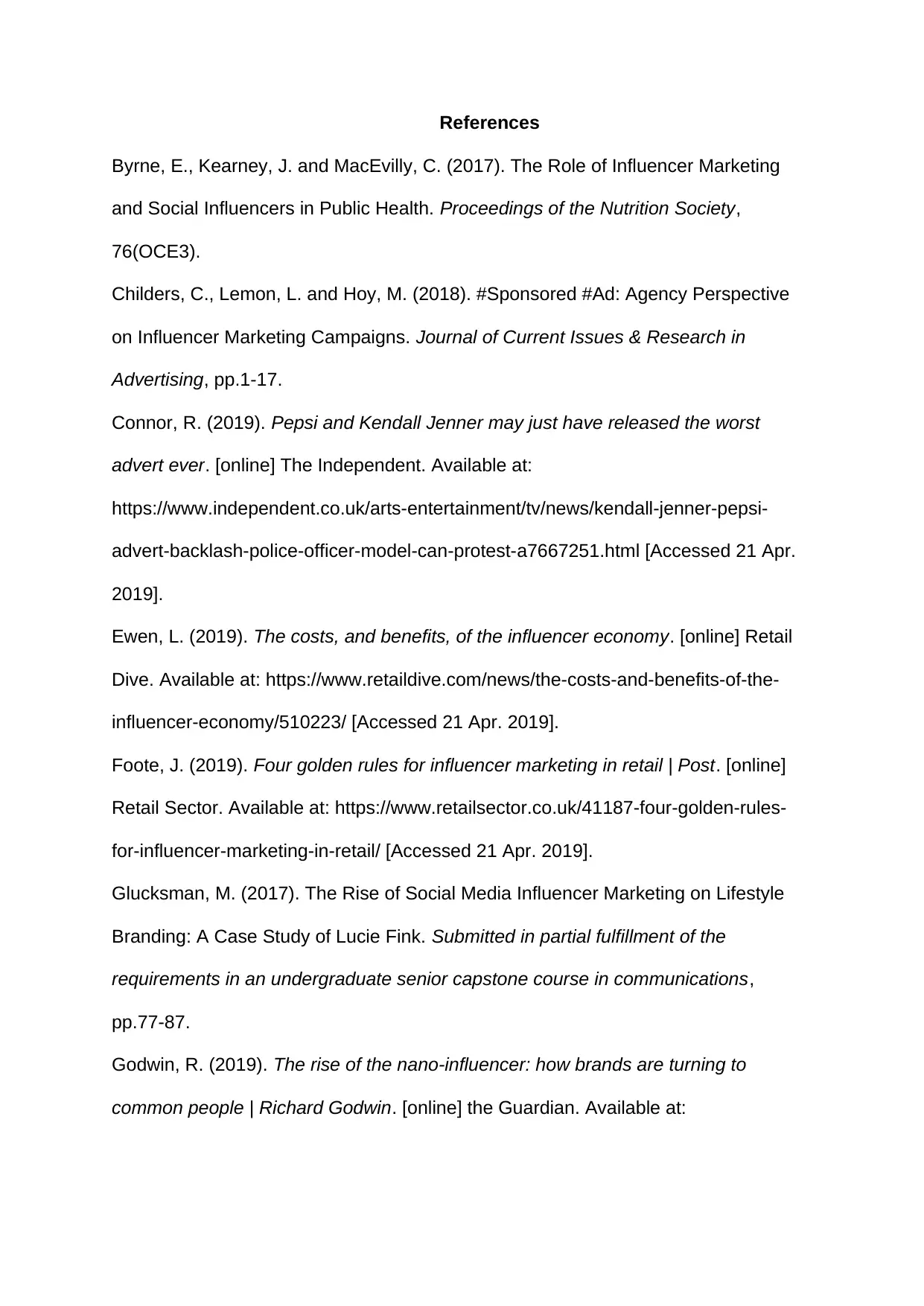
References
Byrne, E., Kearney, J. and MacEvilly, C. (2017). The Role of Influencer Marketing
and Social Influencers in Public Health. Proceedings of the Nutrition Society,
76(OCE3).
Childers, C., Lemon, L. and Hoy, M. (2018). #Sponsored #Ad: Agency Perspective
on Influencer Marketing Campaigns. Journal of Current Issues & Research in
Advertising, pp.1-17.
Connor, R. (2019). Pepsi and Kendall Jenner may just have released the worst
advert ever. [online] The Independent. Available at:
https://www.independent.co.uk/arts-entertainment/tv/news/kendall-jenner-pepsi-
advert-backlash-police-officer-model-can-protest-a7667251.html [Accessed 21 Apr.
2019].
Ewen, L. (2019). The costs, and benefits, of the influencer economy. [online] Retail
Dive. Available at: https://www.retaildive.com/news/the-costs-and-benefits-of-the-
influencer-economy/510223/ [Accessed 21 Apr. 2019].
Foote, J. (2019). Four golden rules for influencer marketing in retail | Post. [online]
Retail Sector. Available at: https://www.retailsector.co.uk/41187-four-golden-rules-
for-influencer-marketing-in-retail/ [Accessed 21 Apr. 2019].
Glucksman, M. (2017). The Rise of Social Media Influencer Marketing on Lifestyle
Branding: A Case Study of Lucie Fink. Submitted in partial fulfillment of the
requirements in an undergraduate senior capstone course in communications,
pp.77-87.
Godwin, R. (2019). The rise of the nano-influencer: how brands are turning to
common people | Richard Godwin. [online] the Guardian. Available at:
Byrne, E., Kearney, J. and MacEvilly, C. (2017). The Role of Influencer Marketing
and Social Influencers in Public Health. Proceedings of the Nutrition Society,
76(OCE3).
Childers, C., Lemon, L. and Hoy, M. (2018). #Sponsored #Ad: Agency Perspective
on Influencer Marketing Campaigns. Journal of Current Issues & Research in
Advertising, pp.1-17.
Connor, R. (2019). Pepsi and Kendall Jenner may just have released the worst
advert ever. [online] The Independent. Available at:
https://www.independent.co.uk/arts-entertainment/tv/news/kendall-jenner-pepsi-
advert-backlash-police-officer-model-can-protest-a7667251.html [Accessed 21 Apr.
2019].
Ewen, L. (2019). The costs, and benefits, of the influencer economy. [online] Retail
Dive. Available at: https://www.retaildive.com/news/the-costs-and-benefits-of-the-
influencer-economy/510223/ [Accessed 21 Apr. 2019].
Foote, J. (2019). Four golden rules for influencer marketing in retail | Post. [online]
Retail Sector. Available at: https://www.retailsector.co.uk/41187-four-golden-rules-
for-influencer-marketing-in-retail/ [Accessed 21 Apr. 2019].
Glucksman, M. (2017). The Rise of Social Media Influencer Marketing on Lifestyle
Branding: A Case Study of Lucie Fink. Submitted in partial fulfillment of the
requirements in an undergraduate senior capstone course in communications,
pp.77-87.
Godwin, R. (2019). The rise of the nano-influencer: how brands are turning to
common people | Richard Godwin. [online] the Guardian. Available at:
⊘ This is a preview!⊘
Do you want full access?
Subscribe today to unlock all pages.

Trusted by 1+ million students worldwide
1 out of 16
Related Documents
Your All-in-One AI-Powered Toolkit for Academic Success.
+13062052269
info@desklib.com
Available 24*7 on WhatsApp / Email
![[object Object]](/_next/static/media/star-bottom.7253800d.svg)
Unlock your academic potential
Copyright © 2020–2025 A2Z Services. All Rights Reserved. Developed and managed by ZUCOL.





